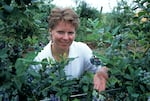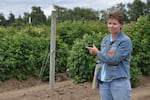
Bernadine Strik sits for an interview with OPB's Superabundant team on October 17, 2022. Known as the Berry Goddess, her decades of work with Oregon blueberries changed the way the crop is grown today.
Brandon Swanson / OPB
An icon in Oregon’s agriculture industry has died. For 34 years, Bernadine Strik did groundbreaking work in the field of horticulture, as both a professor in the Department of Horticulture at Oregon State University and as the lead horticulturist for a one-of-a-kind cooperative berry breeding program.
When interviewed last fall, Strik said working with berries was her dream job.
“I got to have a job where I did research, extension, working with the growers, and teaching undergrads and grads in all berry crops that are important to Oregon. So, a dream job for me.”
The 100-year-old berry breeding program is a collaboration between OSU and the USDA Agricultural Research Service. During her three and a half decades with the program, Strik co-released 38 different berry cultivars and revolutionized how some crops are grown today.
Her passion also earned her a unique moniker.
“At one of the dean’s dinners about five years before I retired, the Dean of the College of Ag Sciences at OSU introduced me as the Berry Goddess,” said Strik. “And I thought, ‘Man, if you have a nickname, that’s a good one!’”

Bernadine Strik inspecting organic blueberries in a test plot at OSU's North Willamette Research and Extension Center on July 23, 2013.
Lynn Ketchum / Courtesy of Oregon State University
Strik was a world traveler — something that started at a young age. Born in the Netherlands, her family moved to Australia when she was a toddler. Around age 9, they relocated to Vancouver Island. In Canada, Strik’s parents owned an ornamental nursery farm and a retail nursery. Working in horticulture, she said, was in her blood.
Strik’s undergraduate degree was on ornamental landscape plants, but she said she was desperate to work on something she could eat. Strik’s PhD was on strawberries, which she said hooked her as soon as she started working with them.
“They’re fun to work with because you can get results quickly, whether it’s in breeding or in production research,” she said. “And who doesn’t love to eat berries?”
Strik may have been the goddess of all berries, but she was best known for her ground-breaking research on blueberries, which completely changed how the crop is grown in the Pacific Northwest and beyond.
When Strik started working for OSU in 1987, Oregon’s blueberry industry was in its infancy. At the time, blueberry bushes were typically planted four feet apart because of how large the bushes grew when they reached maturity. But Strik had a hunch they could be planted closer together, which turned out to be right. And the new 3-foot spacing resulted in 50 percent more fruit during the establishing years for the blueberries. She also studied trellising the plants, keeping the bushes more upright, in hopes to improve how the berries were harvested. Strik realized that as machine harvesting gained popularity, trellising could keep more fruit on the plant. The closer spacing and use of trellises became standard for growers in Oregon and beyond.
“She would do research related to pruning, optimization of various production systems, research on plant nutrition, conventional production systems as well as organic production systems.” said Bill Braunworth, the Department Head of the Department of Horticulture at Oregon State University. “She was an important research and development arm to this growing industry in Oregon.”

Bernadine Strik sits among a crop of Oregon blueberry bushes, June 28, 2002. Her groundbreaking 14-year project on organic blueberry production helped increase the state's acreage from 2% in 2006 to 20% in 2020.
Steve Dodrill / Courtesy of Oregon State University
During Strik’s tenure, the acreage of blueberries in Oregon grew tenfold—from 1,200 to 15,000 acres — largely because of the new systems based on her research.
Braunworth knew Strik throughout her career in Oregon, starting at OSU just a year before her. He says one of her greatest strengths was being able to translate scientific knowledge into practical applications.
“Her ability to communicate and relate to farmers that are doing the real work of production, learning from them what their issues and barriers are, is a big part of [her] story,” said Braunworth. “Oregon State University has a mission of outreach and engagement through our extension programs, a mission of teaching and a mission of research… She was blending those three missions seamlessly and we always pointed to her work with a lot of pride.”
Strik was a mentor to many, leaving a legacy in her students. During her career at OSU she advised 23 graduate students, 7 undergrads, and served on the committee for an additional 35 graduate students.
“She took great pride in [mentorship].” said Stacy Simonich, Dean at Oregon State University’s College of Agricultural Sciences. “She was an authentic leader who boosted others up … including myself, including her students, including the people who worked with her, research associates, she boosted everybody up.”

Bernadine Strik shares her research on berries at OSU's North Willamette Research and Extension Center in Aurora, OR July 8, 2009.
Tiffany Woods / Courtesy of Oregon State University
As a scientist and a mother, Strik was also a role model for women in STEM, something important to Simonich, who met Strik early in her own career.
“At that time I had just had my son Noah and later adopted my daughter Grace, and she just showed me that you could be a really good scientist and you could also be a mom.”
And Simonich said it may be part of the reason she holds the position she does today.
“I’ve strived to be like Bernadine as a scientist, as a person, as a mother,” she said. “And it’s given me strength to do things like this being the first female dean of OSU’s College of Agricultural Sciences.”
Strik’s passion for her work was only matched by her passion for her family. As part of an oral history recorded at OSU, Strik said “The most important thing, certainly in my life, is family.”
A huge advocate for work-life balance, Strik led by example, traveling the world with her family and enjoying being out in nature, hiking along Pacific Northwest trails with daughters Nicole and Shannon and husband Neil Bell.
“[She was] just a role model for me and for others,” said Simonich. “Whatever she did, she did it with passion and maybe she was just really good at figuring out those things that fueled her passion.”
Strik died April 14, 2023 in Corvallis at the age of 60. She leaves behind her husband, two daughters, and an unmatched legacy as the Berry Goddess of Oregon.
